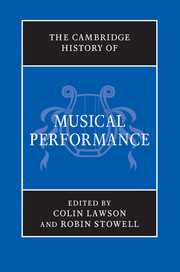Book contents
- Frontmatter
- PART I PERFORMANCE THROUGH HISTORY
- PART II PRE-RENAISSANCE PERFORMANCE
- PART III PERFORMANCE IN THE RENAISSANCE (C. 1430–1600)
- PART IV PERFORMANCE IN THE SEVENTEENTH CENTURY
- PART V PERFORMANCE IN THE ‘LONG EIGHTEENTH CENTURY’
- 20 Performance in the ‘long eighteenth century’: an overview
- 21 Vocal performance in the ‘long eighteenth century’
- 22 Instrumental performance in the ‘long eighteenth century’
- 23 Case study: Mozart, Symphonies in E flat major K543, G minor K550 and C major K551
- PART VI PERFORMANCE IN THE NINETEENTH CENTURY
- PART VII THE TWENTIETH CENTURY AND BEYOND
- PART VIII
- Index
21 - Vocal performance in the ‘long eighteenth century’
from PART V - PERFORMANCE IN THE ‘LONG EIGHTEENTH CENTURY’
Published online by Cambridge University Press: 28 March 2012
- Frontmatter
- PART I PERFORMANCE THROUGH HISTORY
- PART II PRE-RENAISSANCE PERFORMANCE
- PART III PERFORMANCE IN THE RENAISSANCE (C. 1430–1600)
- PART IV PERFORMANCE IN THE SEVENTEENTH CENTURY
- PART V PERFORMANCE IN THE ‘LONG EIGHTEENTH CENTURY’
- 20 Performance in the ‘long eighteenth century’: an overview
- 21 Vocal performance in the ‘long eighteenth century’
- 22 Instrumental performance in the ‘long eighteenth century’
- 23 Case study: Mozart, Symphonies in E flat major K543, G minor K550 and C major K551
- PART VI PERFORMANCE IN THE NINETEENTH CENTURY
- PART VII THE TWENTIETH CENTURY AND BEYOND
- PART VIII
- Index
Summary
Public music-making in the eighteenth century was essentially a sociable and an urban activity, with singing to be encountered in the streets, in theatres, concert rooms and churches, as well as in the drawing rooms of the wealthy. At the end of the seventeenth century there was still a recognised division between ‘gentlemen’, who made music for their own pleasure, and masters, ‘who are to earn their support by pleasing not themselves, for it is their day labour, but others’, as Roger North put it. This socio-musical distinction is one of the defining aspects of the period, but by the early years of the nineteenth century the line between gentlemen and players was less distinct; there was an international opera circuit, institutionalised music teaching, and a popular engagement with singing and singers that would have been unrecognisable to the dilettante of a hundred years earlier. The period saw some of the most important developments in the history of singing; the castrati came into their own and continued to represent the acme of vocalism even as great women soloists established themselves as serious competitors. It was the age of the first star tenor soloists – not the power performers that we now associate with the voice, but lyrical singers, often taught by castrati, who exploited their head register to take them to great heights. Twentieth-century music history identified two distinct eighteenth-century periods – the Baroque and the Classical – but in practice the developments in composition meant very little to singers, whose freely creative contribution to the art of performance was probably greater than at any time before or since. There is some evidence that the Renaissance ideal of separate performance styles for church, chamber and theatre continued on into the eighteenth century, but the differences between them were increasingly of scale rather than substance (and the aristocratic ‘chamber’ increasingly gave way to the bourgeois drawing room).
- Type
- Chapter
- Information
- The Cambridge History of Musical Performance , pp. 506 - 526Publisher: Cambridge University PressPrint publication year: 2012

